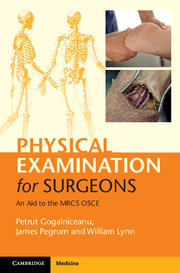Book contents
- Frontmatter
- Dedication
- Contents
- List of contributors
- Introduction
- Acknowledgments
- List of abbreviations
- Section 1 Principles of surgery
- Section 2 General surgery
- Section 3 Breast surgery
- Section 4 Pelvis and perineum
- Section 5 Orthopaedic surgery
- 14 Generic joint examination
- 15 Examination of gait
- 16 Examination of the cervical and thoracic spine
- 17 Cervical spine injury: assessment in trauma
- 18 Examination of the shoulder
- 19 Examination of the elbow
- 20 Examination of the lumbar spine and sacroiliac joint
- 21 Examination of the hip
- 22 Examination of the knee
- 23 Examination of the ankle
- Section 6 Vascular surgery
- Section 7 Heart and thorax
- Section 8 Head and neck surgery
- Section 9 Neurosurgery
- Section 10 Plastic surgery
- Section 11 Surgical radiology
- Section 12 Airway, trauma and critical care
- Index
23 - Examination of the ankle
from Section 5 - Orthopaedic surgery
Published online by Cambridge University Press: 05 July 2015
- Frontmatter
- Dedication
- Contents
- List of contributors
- Introduction
- Acknowledgments
- List of abbreviations
- Section 1 Principles of surgery
- Section 2 General surgery
- Section 3 Breast surgery
- Section 4 Pelvis and perineum
- Section 5 Orthopaedic surgery
- 14 Generic joint examination
- 15 Examination of gait
- 16 Examination of the cervical and thoracic spine
- 17 Cervical spine injury: assessment in trauma
- 18 Examination of the shoulder
- 19 Examination of the elbow
- 20 Examination of the lumbar spine and sacroiliac joint
- 21 Examination of the hip
- 22 Examination of the knee
- 23 Examination of the ankle
- Section 6 Vascular surgery
- Section 7 Heart and thorax
- Section 8 Head and neck surgery
- Section 9 Neurosurgery
- Section 10 Plastic surgery
- Section 11 Surgical radiology
- Section 12 Airway, trauma and critical care
- Index
Summary
Checklist
WIPER
• Patient standing in shorts or underwear; ankles and feet exposed with shoes and socks removed.
• Access is required to the spine, hip and knees to carry out a full biomechanical assessment.
Physiological parameters
Gait
• Antalgic gait
• Walking aids or orthotics
• Observation of footwear
Look
• Skin: scars, erythema, corns and callosities, skin or toe nail changes
• Soft tissues: swelling, proximal disuse muscle atrophy
• Bone:
• foot: deformity, asymmetry, pes cavus, pes planus, equinus ankle, everted foot
• heel: calcaneal valgus/varus
• toes: toes number and alignment, overriding toes, hammer toes, hallux valgus, bunions
Feel
• Skin: temperature, tenderness, sensation
• Soft tissues:
• anterior: extensor tendons, pulses, capillary refill time
• sides: lateral and medial tendons and ligaments; sinus tarsi
• posterior: Achilles tendon
• plantar aspect: plantar fascia
• Bone:
• bone and joint contours: proximal fibular head and neck; talus and calcaneum
• Ottawa ankle rules for suspected ankle fractures
Move
• Active:
• plantarflexion/dorsiflexion
• eversion/inversion
• Passive:
• plantarflexion/dorsiflexion
• eversion/inversion
• Resisted:
• ankle plantarflexion/ankle dorsiflexion
• big toe flexion/big toe dorsiflexion
• inversion/eversion
Special tests (* = essential tests)
• Coleman block test*
• Anterior drawer test*
• Talar tilt – medial and lateral tilt of talus while holding the heel (test medial and lateral ligaments)*
• Neuroma squeeze test (for Morton's neuroma)*
• Tinel's sign
• Simmonds – Thompson test
• To complete the examination…
• Examine the joint above (knee) and the joint below (mid and forefoot).
• Check full neurovascular status of the lower limb.
• Order appropriate radiographs and further imaging.
Examination notes
What changes are inspected in the skin?
The quality of the skin around the foot and the presence and site of any ulcers will point the examiner towards underlying neuropathic, venous or arterial pathology.
• Scars from previous ankle open reduction and internal fixation will be sited over their respective malleoli.
• Anterior ankle approaches are used in trauma surgery, ankle replacement or fusion operations.
- Type
- Chapter
- Information
- Physical Examination for SurgeonsAn Aid to the MRCS OSCE, pp. 190 - 202Publisher: Cambridge University PressPrint publication year: 2015



